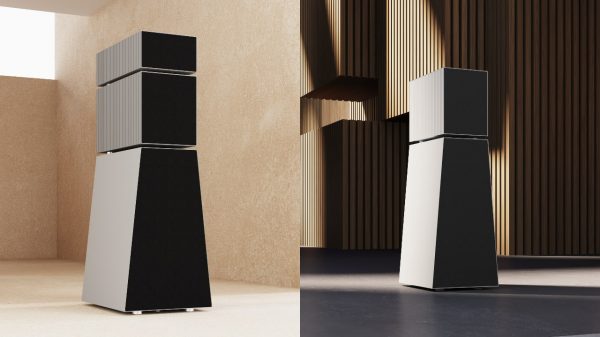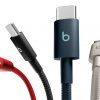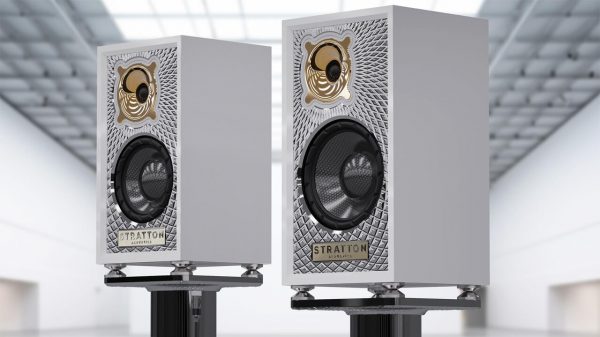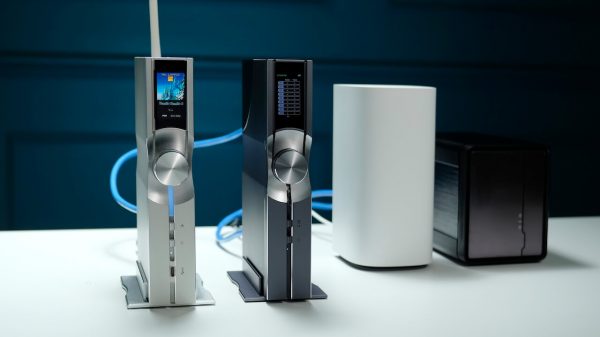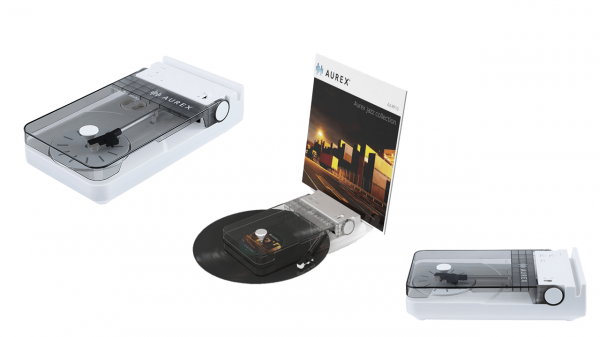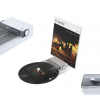New Subwoofer Mines the Deepest Regions of Bass
To most humans and animals, the distant rumbles of ultra-low bass frequencies signal impending danger. Dogs pick up their ears. Wild animals dart through the forest, seeking shelter. The subsonic reverberations of an approaching thunderstorm, earthquake or distant explosion are universal sounds of foreboding.
Producers and sound engineers of blockbuster movies know this, so they add lots of bottomless rumbles to the soundtracks of movies about war, monsters, submarines, and aliens. In big commercial cinemas equipped with an array of powerful subwoofers, these subterranean sounds heighten the realism of the movie surround sound experience, letting you thrill to the mayhem and catastrophe from the safety of a comfy movie seat.
Fidelity to the deepest bass sounds is just as important with music. Pop and rock musicians as well as classical composers understand the power of deep bass. It provides the propulsion for rock songs and is the foundation on which classical symphonies are built. The swell of a huge pipe organ or thrill of a bass drum lends grandeur to classical symphonies and movie soundtrack scores alike. Imagine the opening to Kubrick’s classic film 2001 Space Odyssey without the powerful below-30-Hz organ tones and pounding drums of Strauss’s theme from Also Sprach Zarathustra ?
If we are after realism and fidelity in our home theaters, we gotta have those subterranean frequencies. They are what make movies rock, whether in the cinema or your home theater. But they are tough to generate and a huge challenge to a speaker designer.
The Fundamentals Still Apply
It isn’t clearly understood by most listeners that what many of us describe as “deep bass” isn’t all that low. Taken at face value, the “sub” part of the “subwoofer” means that it should properly deliver deep bass that is below the range of a conventional woofer (bass driver) in a normal speaker system. The problem is that the output of most good conventional subwoofers starts to diminish in the 35-Hz region, and woofer output below that frequency begins to rapidly weaken. Still, many listeners are content with some solid bass in this range. And a rocking electric bass doesn’t go deeper than 40 Hz. As long as lots of conventional subwoofers deliver adequate output in this region and a bit lower, many listeners are satisfied because there is at least the suggestion of deeper bass, if not actual subwoofer output at the frequencies that signal the approach of Godzilla. But what of those specifications that claim serious subwoofer output to 20 Hz or below? The manufacturers aren’t lying: Some of those subs really do produce output at those frequencies, but the way it’s measured involves some creative measurement techniques.
Conventional subwoofers do not just stop dead when they reach their limits of deep bass output. In speaker design lingo, we say that the subwoofer “rolls off,” or gradually produces less and less output below a given frequency. For example, all of the highly regarded subwoofers that Axiom purchased and tested (which shall go unnamed) began to die at 33 Hz or above, although all the specifications claimed significant output to 20 Hz. In other words, a typical sub may have substantial output at 35 Hz, significantly less by 30 Hz, and perhaps a teensy bit at 25 Hz. The woofer cone may move a bit, but its output will be minuscule–such that you won’t hear it in a normal living room. Indeed, the only way for the manufacturer to measure it is to place the sub in a small space (a bathroom or closet would be best) along with the measurement microphone; we all know how well a subwoofer measures in the tiny interior of your car.
The Challenge
We feel sound as well as hear it, so for maximum impact (the profoundly deep sounds you hear from huge subs in some cinemas), you want strong, real, loud undistorted output to 20 Hz and below. Compounding the challenge is another obstacle that relates to how we hear. To make 20-Hz and deeper tones audible requires a great deal more amplifier power and low-frequency output–relative to the midrange and highs–to make those deep subwoofer tones audible. And conventional subs just cannot pressurize enough air in a big room to make those low sub frequencies audible.
This is how Axiom saw the challenge–to produce a subwoofer that was still manageable in its dimensions, affordable to many, had an extremely powerful amplifier, and would move enough air in large rooms to deliver authentic low frequencies, undistorted, at very loud playback levels for home theater movies and music. Axiom knew that to achieve this performance, the laws of physics couldn’t be ignored: a large box, a huge amplifier, and a big driver that wouldn’t overload when it was pushed by hundreds of watts.
The Amplifier 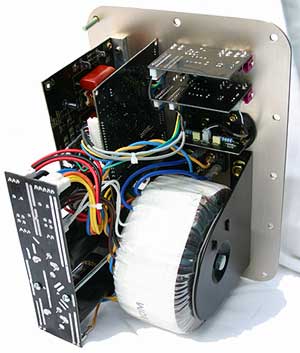
Early on in the design process, an all-analog amplifier design was considered–and rejected. Why? Analog amplifiers have only about 50% efficiency, so if the subwoofer required a 500-watt analog amplifier to drive a 12-inch driver in a large enclosure, it meant that the amp would draw at least 1,000 watts from the AC line. Unfortunately, there is limited access to total power from a house AC outlet. At the least, such a sub might trip the circuit breakers at peak output or cause brownouts and disrupt performance of other household electrical appliances, including your projector or TV.
The alternative to this scenario was apparent: a digital switching amplifier, because of its inherent high efficiency of 90%. Many existing subwoofers already use digital switching amplifiers because they are efficient, cool-running, lightweight, and relatively economical. But conventional digital subwoofer amplifiers have a severe limitation: no headroom. When a digital amplifier reaches it output limits, instant distortion results. And given that movie soundtracks and large musical works have sudden dynamic swings that demand sudden bursts of power, this didn’t seem the appropriate choice.
The solution was to design an analog power supply (not a digital switching supply) that would give the digital amplifier plenty of headroom for large dynamic peaks. Additionally, output devices were selected for their ability to deliver huge amounts of current. The new design produces 600 watts with headroom to spare. Axiom also realized that an entirely new driver design would be required to handle such power and attain the design goal of deep bass response to 17 Hz with a maximum undistorted output greater than 110 dB SPL.
The Driver and the Box 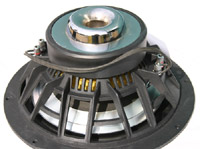
A massive 12-inch aluminum-cone driver with a 3-inch diameter dual voice coil was designed (the dual voice coil lowers the internal impedance to 1.3 ohms, so the digital amp can utilize high-current drive)(pictured left). In terms of deep bass extension, Axiom knew that total box volume vs. driver diameter still rule, so a vertical enclosure measuring about 46 x 15 x 17 inches was proposed. By combining the new driver with the application of a very long tuned port (3 feet!) in a large enclosure and the assistance of the XLF (Digital Signal Processing of the response), the desired bass extension to 16 Hz in an anechoic environment was achievable.
Digital Signal Processor
But one enormous problem remained: how to make the subwoofer deliver smooth and consistent performance to its output limits (16 Hz) without overtaxing the driver and the amplifier. The answer was to use Digital Signal Processing, and a custom-designed “algorithm.” The latter term is in common usage amongst digital engineers (not so common to acoustical engineers though), and in essence, it’s a kind of digital road map that can be programmed by the engineer to command a digital signal to perform in a particular way with a specific driver. The Epicenter EP600’s DSP circuit and algorithm know in advance the performance goals of the sub, the output capabilities of the powerful digital amplifier, and the capabilities of the new driver. It automatically corrects any slight deviations of the big woofer away from the design goal, and it also prevents the subwoofer amplifier from exceeding its output limits and going into distortion. The result is a subwoofer that offers unprecedented performance. The EP600’s output measured anechoically (in a room with total absorption) or in free air, extends to 17 Hz +/-1 dB and to 16 Hz +/-3 dB. Used in a typical room with the boundary reinforcements that normally apply, extension to 13 Hz is possible. The EP600’s XLF (Extended Low Frequency algorithm) DSP enables maximum sound levels to an unprecedented 111 dB anechoic, and 122 dB SPL in a typical room, output and extension that are clearly able to reproduce Godzilla’s footfalls at real-life levels!
And because of the DSP, the EP600 can’t be overdriven into distortion. You can keep increasing the volume level with impunity. It will reach its maximum and go no further, nor can you damage the driver. All the time the DSP’s algorithm tells the amplifier to stop delivering more power to the driver to prevent distortion.
While it’s operating, the DSP constantly monitors the power supplied to the driver, correcting any tendency for the driver and system to deviate more than 1.5 dB away from the performance goal (linear output in an anechoic environment). What this means in practical terms is that if you feed any frequency between 17 Hz and 100 Hz to the EP600, it will deliver that frequency with, at most, an undetectable variation of 1.5 dB. And it will mine even lower frequencies with as much precision, all the way down to 17 Hz with the same 1.5 dB of variation.
Some of the EP600’s other characteristics are relevant: It weighs 100 pounds, and you can request it in a horizontal version so you can conceal it behind a sofa or put it away at one side of the room. And for those willing to accept just 2 dB less in maximum output (109 dB anechoic/120 dB in-room) and a bit less extension to 19 Hz anechoic and 15 Hz in-room, there is the Epicenter EP500, a somewhat smaller version with the same massive driver, slightly less power output (500 watts vs. the larger sub’s 600 watts), and, at $1150, a price that’s $600 less than the larger sub (the EP600 is $1750).
Looking for a new subwoofer? Start by visiting Axiom’s subwoofer page to see what you need to consider.


